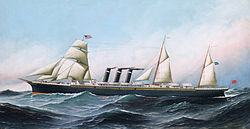City of Paris (ship, 1889)
|
Painting of the City of Paris by Antonio Jacobsen
|
||||||||||||||||||||||||
|
||||||||||||||||||||||||
|
||||||||||||||||||||||||
|
||||||||||||||||||||||||
|
||||||||||||||||||||||||
The City of Paris was a passenger ship that entered service for the British Inman Line in 1889 . From May 1889 to August 1891 she held the Blue Ribbon as the fastest passenger ship on the North Atlantic route and was the sister ship of the City of New York , which became known primarily for its near collision with the Titanic in April 1912. The City of Paris has operated under the name Paris since the merger of the Inman Line with the American Line in 1893 . She was renamed several times in the course of her service before she was retired in 1920 and three years later was scrapped in Genoa, Italy . She was the last passenger ship built for the Inman Line.
Planning and construction
The City of Paris and its sister ship the City of New York were planned as an answer for the newbuildings of the British shipping companies White Star Line and Cunard Line and co-financed by the Pennsylvania Railroad . The appearance of the new ships was based on a slightly enlarged version of the City of Rome that entered service in 1881.
The newbuildings had an elegant clipper bow, which was also taken over from the predecessor ship City of Rome . The sister ships were equipped with bathrooms with running hot water, electric fans and electric light. The first and second class rooms such as the smoking room or the library were paneled with walnut wood. The first class dining room had a glass dome to let natural light into the interior of the ship.
The City of Paris was built under number 241 at John Brown & Company in Clydebank and launched on October 20, 1888. In April 1889 the ship was finally delivered to the Inman Line.
period of service
The first years of service
The City of Paris entered service on the North Atlantic route on April 3, 1889. A month later, she won the Blue Ribbon in both directions with an average speed of 19.95 knots.
On March 25, 1890, one of the ship's two propeller shafts broke during another crossing. The incident damaged the hull of the City of Paris , flooding both engine rooms of the ship. The City of Paris was towed into the nearest port. The repair work on the ship lasted for a year.
In July 1891, the speed record was City of Paris to the west of the White Star Line belonging Majestic broken. In August, the sister ship Teutonic also broke the speed record in an easterly direction, causing the City of Paris to lose the Blue Ribbon.
The City of Paris remained in service for Inman until the shipping company was taken over by American Line in 1893. The City of Paris from then on ran under the American flag and was renamed Paris , but continued to operate on the North Atlantic route.
Spanish-American War
Ten days before the outbreak of the Spanish-American War , the US government seized the Paris together with the shipping company's other passenger ships in order to convert them into troop carriers . Within just three days, the ship , which has now been renamed Yale , was equipped with on-board guns and converted for war use. In the months that followed, the ship was used to transport troops until it was returned to the American Line in August 1898.
Return to passenger service
In December 1898, the Paris returned to passenger service. Already on her first civilian voyage after her deployment as a troop transport, she hit the headlines when she rescued 22 of 23 crew members of the British tanker Vindobala , which had sunk in rough seas.
During another crossing in a westerly direction, the Paris ran aground on May 2, 1899 due to heavy fog off Cornwall . Since it was initially considered a total write-off , it stayed offshore for two months before being towed to Belfast for repairs, severely damaged . The repair work was used to modernize the aging ship. Among other things, the three chimneys were replaced by two higher ones. In addition, the ship's machinery was renewed. In August 1901, the Paris was put back into service under the new name Philadelphia .
In 1913 the Philadelphia was rebuilt again and henceforth used as an emigrant ship, whereby the first class of the ship was omitted. Since the Philadelphia was initially neutral, it could also be used profitably in the first years of the World War . After the United States entered the war, however, it was again confiscated and used as a troop transport under the name Harrisburg .
In September 1919, the ship returned to civil service as Philadelphia and remained in service between New York and Southampton for a further nine months before being retired in June 1920. After two years of lay-in , the ship was brought to Italy and was then to be used as a liner passenger ship in the Mediterranean , but this was not realized. Instead, the Philadelphia was launched in Naples and scrapped in 1923 together with her sister ship in Genoa .
Web links
- Entry to the ship on clydesite.co.uk (English)
- History of the ship on greatships.net (English)
- Report on the service of the ship as the USS Yale (English)


